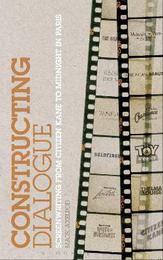
|
Constructing Dialogue: Screenwriting from Citizen Kane to Midnight in Paris
Hardback
Main Details
| Title |
Constructing Dialogue: Screenwriting from Citizen Kane to Midnight in Paris
|
| Authors and Contributors |
By (author) Mark Axelrod
|
| Physical Properties |
| Format:Hardback | | Pages:328 | | Dimensions(mm): Height 229,Width 152 |
|
| Category/Genre | Film scripts and screenplays |
|---|
| ISBN/Barcode |
9781441174253
|
| Classifications | Dewey:808.23 |
|---|
| Audience | | Tertiary Education (US: College) | |
|---|
|
Publishing Details |
| Publisher |
Bloomsbury Publishing Plc
|
| Imprint |
Bloomsbury Academic USA
|
| Publication Date |
2 January 2014 |
| Publication Country |
United States
|
Description
Unlike most screenwriting guides that generally analyze several aspects of screenwriting, Constructing Dialogue is devoted to a more analytical treatment of certain individual scenes and how those scenes were constructed to be the most highly dramatic vis a vis their dialogue. In the art of screenwriting, one cannot separate how the scene is constructed from how the dialogue is written. They are completely interwoven. Each chapter deals with how a particular screenwriter approached dialogue relative to that particular scene's construction. From Citizen Kane to The Fisher King the storylines have changed, but the techniques used to construct scene and dialogue have fundamentally remained the same. The author maintains that there are four optimum requirements that each scene needs in order to be successful: maintaining scenic integrity; advancing the storyline, developing character, and eliciting conflict and engaging emotionally. Comparing the original script and viewing the final movie, the student is able to see what exactly was being accomplished to make both the scene and the dialogue work effectively.
Author Biography
Mark Axelrod is a Full Professor of English and Comparative Literature, and Director of the John Fowles Center for Creative Writing, at Chapman University, USA.
ReviewsConstructing Dialogue reveals unprecedented insights into the pivotal impact of dialogue on cinematic craftsmanship. Axelrod's nuanced analysis of great Hollywood scripts investigates dialogue as an active tactical element that operates with, rather than against, visual artistry. At once gleeful, rigorous and practical, Axelrod shows that the best feature screenplays are structured down to even the "micro" level of a single well-crafted line. Crucial reading for aspiring screenwriters, film students, seasoned filmmakers and film buffs alike, Axelrod uncovers the bare bones of the screenplay, the writer's ecstatic dance with words, structure and story. -- Valorie D. Thomas, Associate Professor of English and Africana Studies, Pomona College, US I wish I could have had at hand such a great screenwriting guide in my first steps as a student and filmmaker. It could have saved me a lot of trouble, by speeding up my own development in this area. Script doctor and visionary creative writer Axelrod provides the art of motion pictures - and film industry in general - with a unique guide that will certainly expand film possibilities over the years to come. Axelrod's book on dialogue construction can perfectly match Joseph Campbell's revolutionary writings that changed film narrative forever. -- Gustavo Letelier, professor and award-winning film director, Chile Axelrod does what Axelrod does best: knows dialogue. This unique text elucidates what the preeminent screenwriters have known and accomplished for years; namely, how to say the most with brevity and precision and move the story along. Axelrod shows that in a very succinct, if not unique, way. Anyone interested in the art of dialogue writing should read this. -- David Anspaugh, Director, Hoosiers, Rudy
|